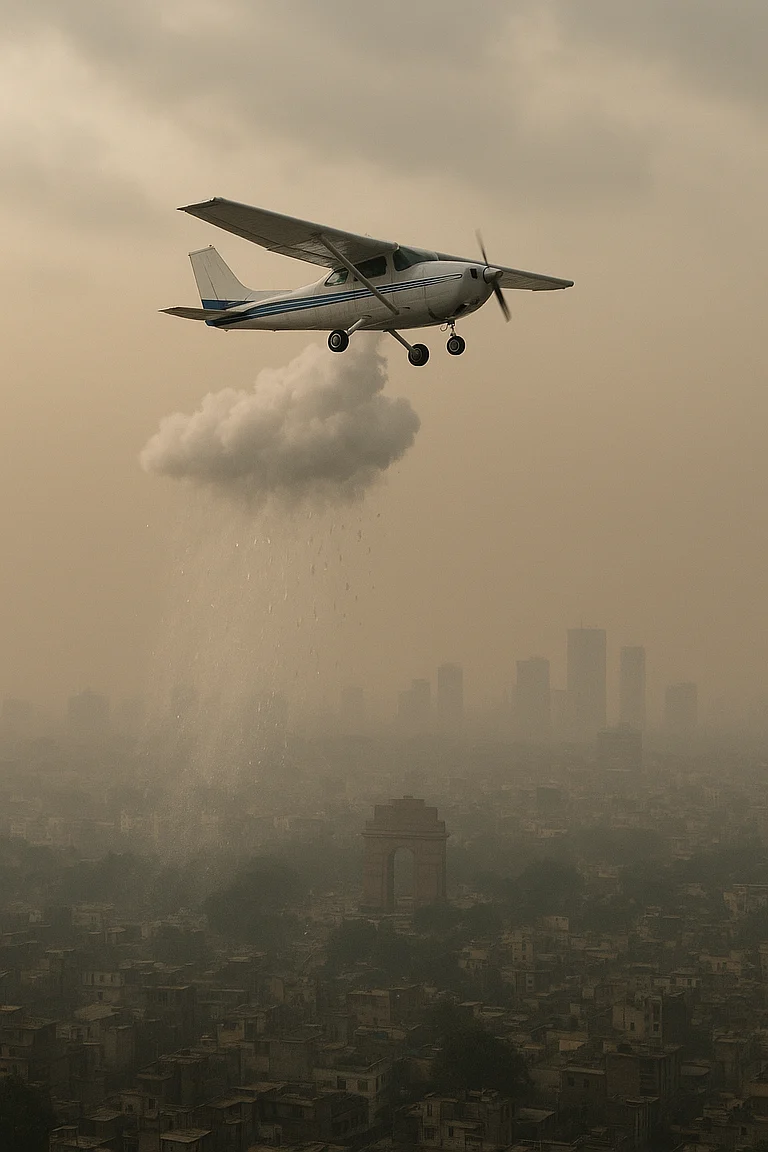Delhi govt and IIT Kanpur conducted second cloud seeding trial on Monday.
IMD reported no rainfall due to only 10–15% moisture levels.
Experts say such trials offer short-term relief, not a lasting pollution fix.
Delhi Govt’s Second Artificial Rain Trial Fails Amid ‘Very Poor’ Air Quality: Here’s Why
Delhi’s second artificial rain trial fails to yield results as low moisture levels hinder cloud seeding
The Delhi government and the Indian Institute of Technology (IIT) Kanpur jointly conducted the trials in areas such as Burari, Karol Bagh, Mayur Vihar, and Badli.
However, the efforts failed as the India Meteorological Department (IMD) did not record any rainfall in the city.
How the Trial Unfolded
The starting point for the Cessna aircraft was the IIT Kanpur airstrip from where the flight took off at 12.13 pm and the seeding points covered were Khekra, Burari, North Karol Bagh, Mayur Vihar, Sadakpur and Bhojpur.
The second seeding sortie was conducted from Meerut airstrip itself, carrying four kilograms of seeding material and landing back at Meerut airstrip.
The seeding started at 3.45 pm, with the first seeding point at Khekra at 4.08 pm, followed by Burari, around Mayur Vihar, Pavi Sadakpur, Noida, Bhojpur, Modinagar and Meerut, landing back at 4.45 pm, the report released by Delhi government said.
Reason for Failure of Trial
The moisture content predicted by the India Meteorological Department (IMD) and other agencies remained low at 10-15 per cent, which is not an ideal condition for cloud seeding. However, this situation is also suitable for judging the effectiveness of the seeding material in low-moisture conditions, PTI reported citing a report released by the Delhi government.
The report noted that winds were negligible at that time but the denser moisture content created due to seeding particles has helped in settling down a portion of these particles, which translated to these reductions.
Experts told TOI that cloud seeding trials are expensive and short-term interventions rather than long-term solution.
Anumita Roychowdhury, Executive Director (Research and Advocacy) at the Centre for Science and Environment (CSE), said, “The city has not yet recorded any substantial rainfall after cloud seeding. Even if rains occur and wash out pollutants, the pollution will bounce back quickly. The impact lasts from hours to a couple of days.”
Meanwhile, IIT Kanpur Director Manindra Agrawal told NDTV that the attempt was “not completely successful” because the clouds lacked enough moisture. “For rain to form, moisture levels of at least 50% are ideal,” he said. “Today’s clouds only had about 15–20% moisture, which reduced the chances of rainfall.”
Business Standard further reported that the trial helped the team gain experience for future operations. The Delhi government is planning two more trials when suitable cloud conditions appear.
According to reports, IIT Kanpur Director Manindra Agrawal told that the next attempt will be made only when the clouds have at least 40-50% moisture.
“We are hoping for a cloud cover over the next 4-5 days and we have kept the aircraft ready in Meerut so that at short notice we can fly. Generally, it will be in the East and North parts of Delhi only. We cannot go West or South because of the airport, and we can't go to the Central area because of the VIP area,” Agrawal was quoted by ANI as saying.
Delhi Environment Minister Manjinder Singh Sirsa confirmed to Moneycontrol that 9-10 more trials are planned in the coming days, depending on weather conditions.
The first round, conducted last week, released six flares at an altitude of around 4,000 feet above ground level, with a burn time of 18.5 minutes.
(With inputs from PTI.)


